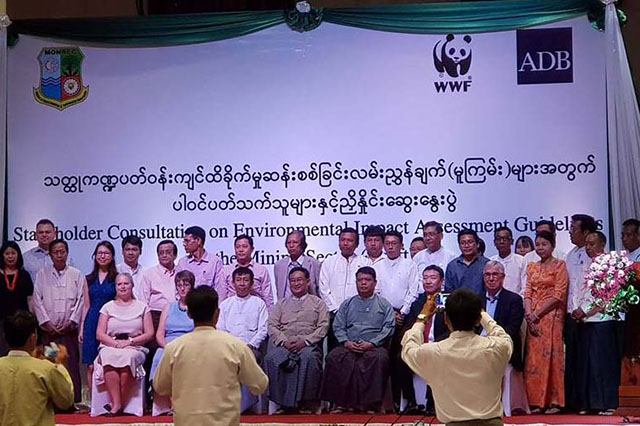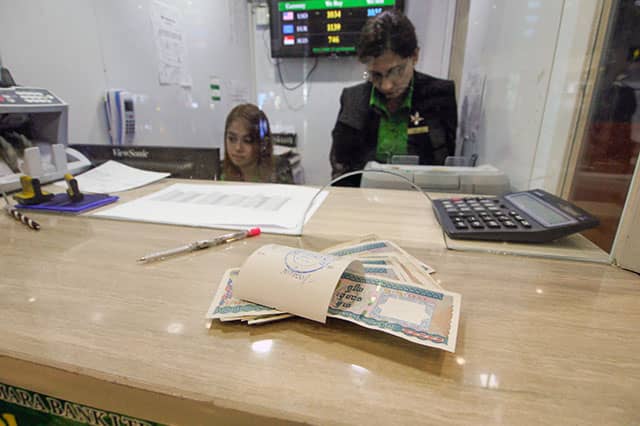Consultation Begins on Draft EIA Guidelines for the Mining Sector

As part of its follow-up to the Mining Sector Wide Impact Assessment (SWIA), which identified environmental and social safeguards and an effective EIA system as fundamental to ensuring better mining practices in Myanmar, on 25 May MCRB supported the Ministry of Natural Resources and Environmental Conservation (MONREC) in facilitating a consultation in Yangon on two draft documents intended to guide those undertaking Environmental Impact Assessments (EIA), Initial Environment Examinations (IEE) and Environmental Management Plans (EMP) for the mining sector, including gemstones and jade. The draft guidelines have been prepared by Myanmar Mining EIA Guidelines Working Group with the technical assistance of Asian Development Bank (ADB) TA 8786-MYA: Environmental Safeguard Institutional Strengthening.
The consultation was attended by over 100 participants, mainly from the mining sector, EIA consultants, and relevant government officials from MONREC (mining, environment and forestry), Ministry of Health and Sport and Ministry of Home Affairs. The Chairs of the Myanmar Federation of Mining Associations (MFMA), and Myanmar Impact Assessment Association were both present and contributed to the discussions. Development partners active in the mining sector were also present.
U Kyaw Hsan, Managing Director of the Mining Enterprise-1 (ME-1) gave the opening speech on behalf of the Ministry and stressed MONREC’s commitment to seeing a more responsible and sustainable mining sector.
Dr San Oo, Director of the Environmental Conservation Dept (ECD) highlighted that 2752 EIA/IEE/EMP documents had been submitted to ECD to date, 77% of them mining related. The majority (1790) were mining EMP, mostly submitted in 2016-2017. 48% of the mining documents were from gemstones and jade sectors, with around 20% each coming from operations under ME-1 and ME-2. (ME-1 is responsible for mining, production and marketing of antimony, lead, zinc, silver, iron, nickel and copper ores. Since the merger of ME-3 and ME-1 in early 2015 ME-1 is now also responsible for limestone. ME-2 is responsible for mining, production and marketing of gold, platinum, tin, tungsten, molybdenum, niobium, columbium, heavy mineral and gold ores).
Dr San Oo explained the process for EIA review, including the 39-member Review Committee, and that this had been subdivided in November 2014 into four subcommittees to facilitate review, including one focussed on mining and energy projects, chaired by EC DG U Hla Maung Thein, on which both he and U Ohn Lwin sits. He noted that the guidelines for a ‘standalone EMP’ for the mining sector had been adopted by ECD on 7-11-2016, based on the 2015 EIA Procedure, and that training had been given to regional officials on how to review these. He noted that the Ministry was very conscious that there remained many weaknesses in the EIA system, including capacity, and highlighted the steps the Ministry planned to take to remedy this, including establishment of guidelines intended to improve the quality of submitted reports, support from international agencies, establishment of a system for international expert review based on payment of review fees under Article 37,64, 77 of the EIA Procedure, and delegation of some review responsibilities to regional teams.
U Ohn Lwin, Director in the Mining Department, presented on the mining sector and related reform initiatives including formation of the merged ministry in 2016, adoption of the 2015 Amended Mining Law and 2018 Rules, delegation of licensing powers for small-scale mines to states/regions, drafting of national gemstones policy, and national mineral resources policy, and establishment of joint inspection teams. As of 30-4-2018, there were 1405 valid mine licences, of which 150 were for large-scale mines, and 786 small-scale.
Robert Everitt, ADB consultant, presented the draft documents for consultation. The documents under consultation are:
-
Mining: Guidelines for Environmental Impact Assessment (English | Burmese)
-
Mining Exploration: Guideline for Preparation of an Environmental Management Plan (English | Burmese)
Both documents are available in English and Burmese (please note Burmese documents are subject to a translation quality review).
Vicky Bowman summarised the main findings of MCRB’s Mining SWIA which set the context for the discussion on how the EIA system should be applied to the mining sector. While EIA was important, it was not the sole tool necessary to fix the many problems of the sector, and in some cases, simple Do’s and Don’ts for companies (particular subsistence miners), training and enforcement was what was required. She noted theimportance of ensuring that EIA Guidelines reflected Myanmar legislation, but that there were many uncertainties, inconsistences and gaps in that legislation including in the Mining Rules, EIA Procedure/Annex, and gaps in laws e.g. occupational health and safety. She drew attention to the list of relevant laws concerning environment and social safeguards which MCRB had compiled while undertaking the Mining SWIA and how these laws interact with one another, and the many development partner projects in the mining sector.
Discussions covered the need for guidelines to be clear, simple, and practical and tailored to the stage of the mining cycle. Clarification of the status of the guidelines as a document prescribing requirements, or simply giving best practice guidance. There was confusion over the role of a ‘stand-alone EMP’, and a lack of clarity of which government agencies were responsible for inspecting and enforcing commitments in EMPs/Environmental Compliance Certificates.
The inclusion of detailed community development plans in EMPs was questioned, as was the appropriateness of ECD seeking to approve these, since they should be negotiated and agreed at local level between company and communities. Translated terms needed to be aligned with mining sector usage and relevant laws. Questions were also raised about the overall management of the EIA process including the urgent need for expert review arrangements to be put in place, and systematic disclosure. Consultants and mining companies called for more clarity in advance on ECD’s expectations, and feedback on documents which had been submitted.
Comments are invited on the two draft documents before 15 June. These should be sent in English or Burmese to the ADB team Robert Everitt and Tin Win Win Ei . Further rounds of consultation will take place on these and other related Mining EIA guidelines documents being prepared under TA 8786-MYA.
Read also
- Mining Sector
- Jade Mining in Kachin State – Environmental Management Plans
- Towards Responsible Gold Mining in Sagaing Region
- River Sand Extraction in Myanmar
- Experts object to firms’ plans to mine sand in Tanintharyi Region
 English
English မြန်မာ
မြန်မာ မြန်မာ (unicode)
မြန်မာ (unicode)










